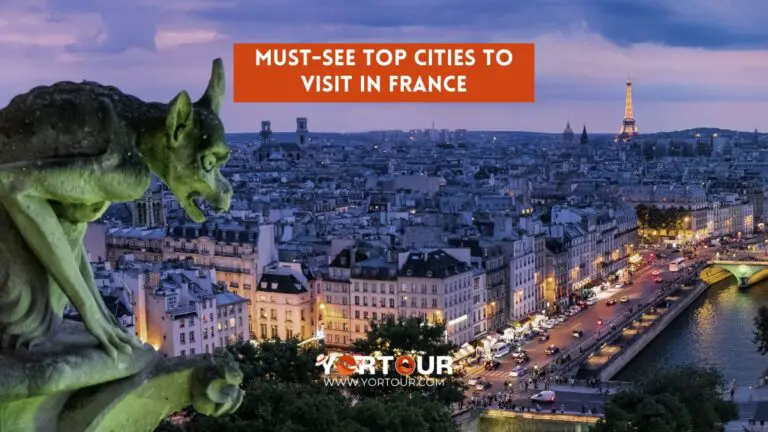Introduction to Top Cities to Visit in France
France is a mosaic of diverse urban landscapes, each city boasting its unique allure and charm. From the romance-infused streets of Paris to the sun-drenched promenades of Nice, French cities are a testament to the country rich history, culture, and gastronomic delights.
Exploring these cities provides a deeper understanding of France multifaceted character and offers travelers a wealth of experiences, from art and architecture to food and festivals. This article delves into Top Cities to Visit in France, each offering a distinct slice of the French way of life.
Paris – The City of Light
Paris, the City of Light, dazzles with iconic landmarks like the Eiffel Tower and Notre Dame Cathedral, each offering a blend of stunning architecture and rich history. The city world-class museums, including the Louvre and Musée d’Orsay, house masterpieces that draw art enthusiasts from around the globe.
Beyond its famous sights, Paris captivates with its charming neighborhoods and vibrant culinary scene. Montmartre bohemian allure and Le Marais eclectic mix of history and modernity invite exploration, while the city cafés, bistros, and nightlife promise unforgettable gastronomic and cultural experiences.
Iconic Landmarks – Eiffel Tower, Notre Dame Cathedral
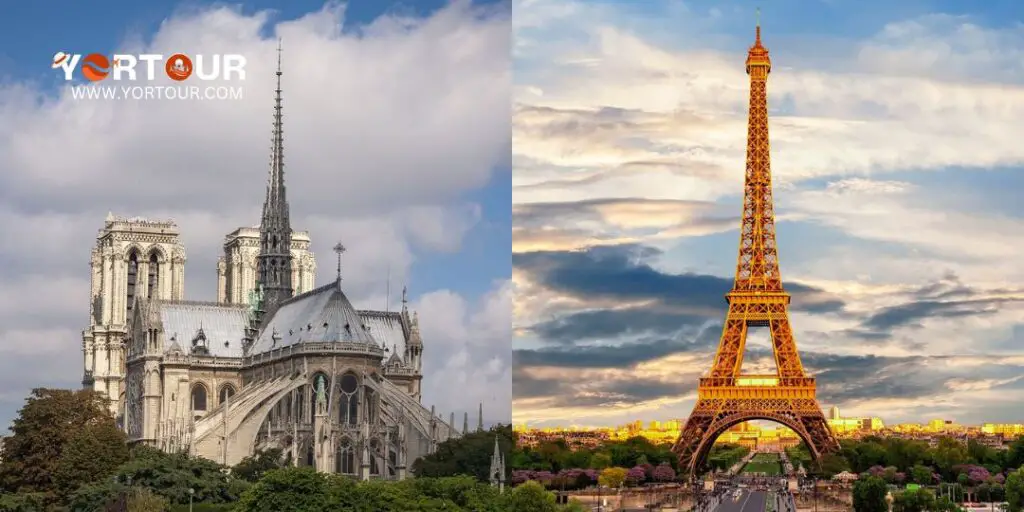
Paris, often referred to as the City of Light, is a city that radiates beauty and history from every corner. The Eiffel Tower, standing majestically over the Seine, is more than just a symbol of Paris; it’s an architectural marvel that offers unparalleled views of the city.
Equally impressive is the Notre Dame Cathedral, a masterpiece of Gothic architecture that has witnessed centuries of history and continues to captivate visitors with its intricate façade and towering spires.
World-Class Museums – The Louvre, Musée d’Orsay

Art enthusiasts will find Paris a paradise, home to some of the world most renowned museums. The Louvre, the largest art museum globally, houses masterpieces like the Mona Lisa and the Venus de Milo, drawing millions of visitors each year.
Nearby, the Musée d’Orsay, set in a former railway station, showcases an extensive collection of Impressionist and Post-Impressionist masterpieces, including works by Monet, Van Gogh, and Degas.
Charming Neighborhoods – Montmartre, Le Marais

The charm of Paris extends beyond its landmarks to its vibrant neighborhoods. Montmartre, with its bohemian past, cobblestone streets, and the iconic Sacré-Cœur Basilica, offers stunning views of the city and a glimpse into the lives of artists like Picasso and Van Gogh. Le Marais, with its medieval lanes, trendy boutiques, and historical sites, blends the old and new, creating a lively and eclectic atmosphere.
Culinary Delights and Nightlife
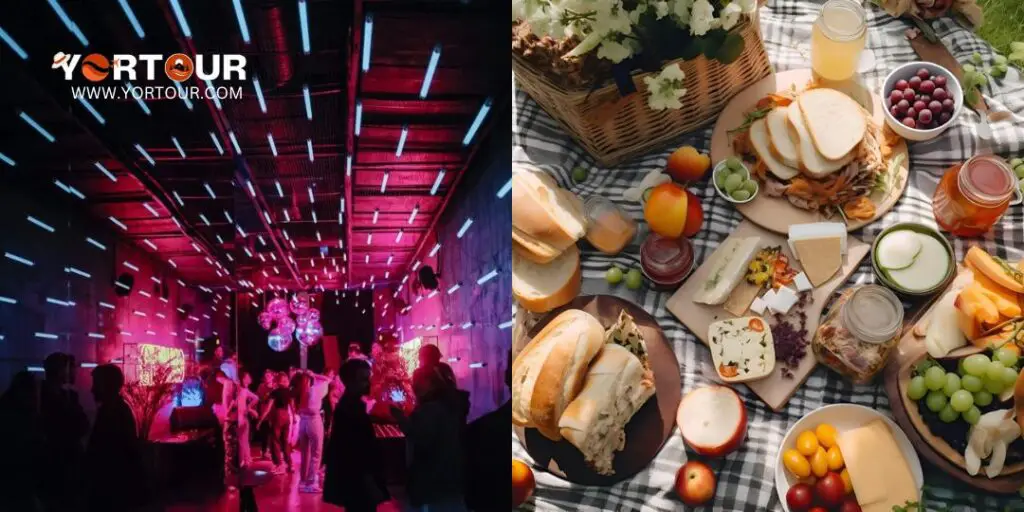
Paris is a culinary capital, offering everything from quaint cafés and bustling bistros to Michelin-starred restaurants. Whether savoring a croissant with coffee at a sidewalk café or indulging in haute cuisine, Paris promises a gastronomic journey that delights the senses. As night falls, the city vibrant nightlife emerges, with an array of bars, clubs, and live music venues keeping the energy high well into the early hours.
Lyon – The Culinary Capital
Lyon, known as the culinary capital of France, boasts a rich history and a vibrant food culture. The city old town, Vieux Lyon, a UNESCO World Heritage site, enchants visitors with its Renaissance architecture, narrow alleys, and hidden courtyards. Lyon renowned food markets, like the Halles de Lyon Paul Bocuse, and traditional bouchons offer a gastronomic feast, featuring delicacies such as coq au vin and quenelles.
Beyond its culinary delights, Lyon impresses with its well-preserved Renaissance buildings and unique traboules in Vieux Lyon. The city also hosts numerous cultural events, including the spectacular Festival of Lights in December, which draws visitors globally with its stunning light installations. Throughout the year, a variety of festivals ensure that Lyon remains a lively and dynamic cultural center.
Historical Significance and UNESCO Status
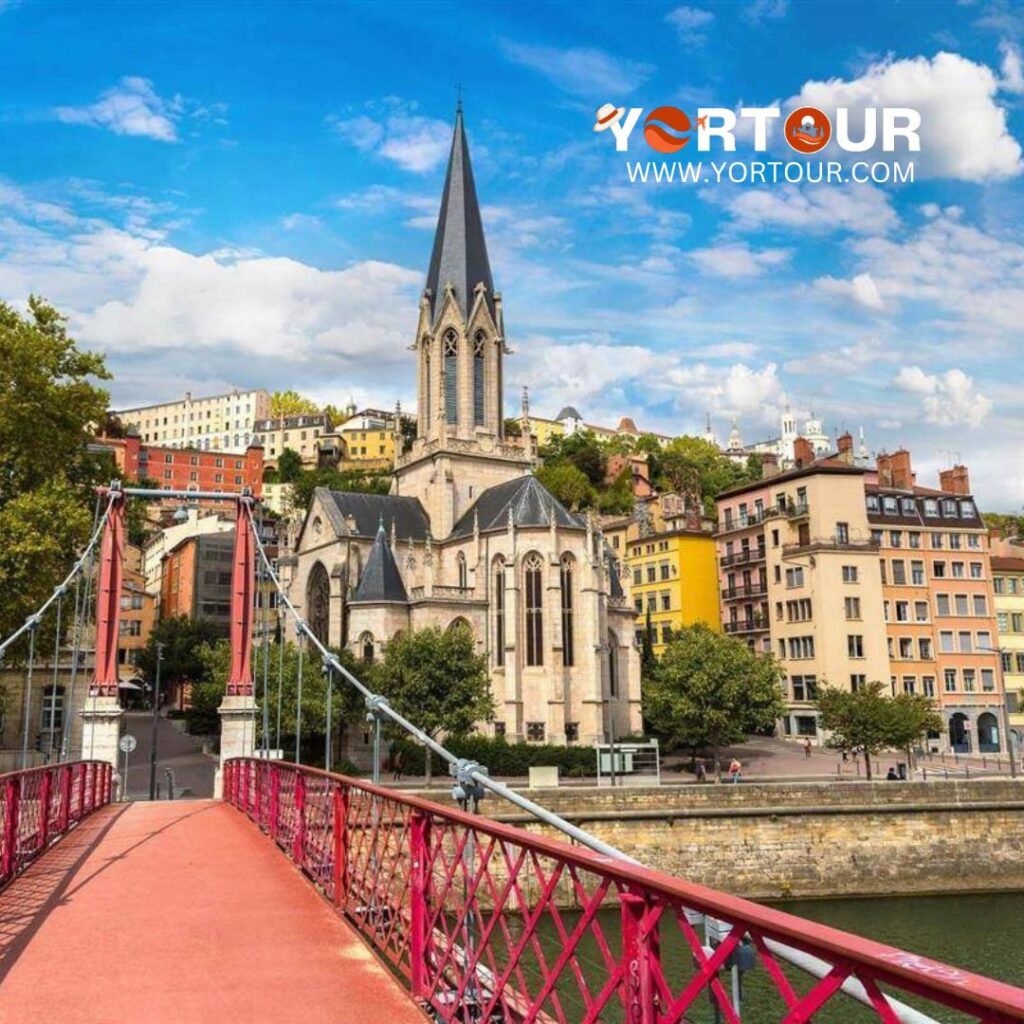
Lyon, often dubbed the culinary capital of France, is a city steeped in history. Its old town, Vieux Lyon, is a UNESCO World Heritage site, filled with Renaissance architecture, narrow alleys, and hidden courtyards. Walking through its streets feels like stepping back in time, with each corner revealing another piece of its storied past.
Renowned Food Markets and Bouchons
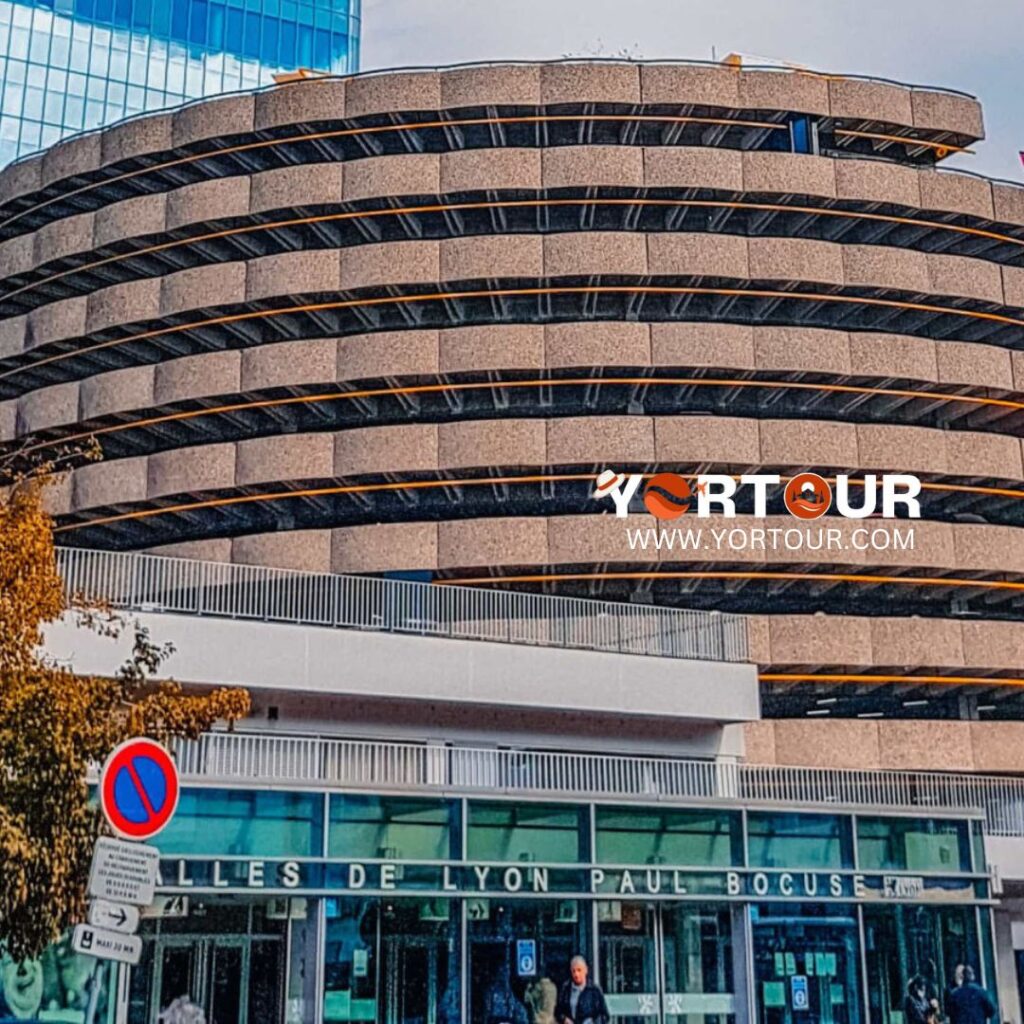
Lyon culinary reputation is well-deserved, thanks to its bustling food markets and traditional bouchons. The Halles de Lyon Paul Bocuse market offers a sensory overload of gourmet delights, from cheeses and charcuterie to pastries and chocolates.
Dining at a bouchon, one of Lyon traditional restaurants, allows visitors to savor hearty Lyonnaise cuisine, characterized by dishes like coq au vin and quenelles.
Vieux Lyon – Renaissance Architecture and Sights

Vieux Lyon, with its well-preserved Renaissance buildings, is a treasure trove of architectural wonders. The district traboules, hidden passageways used by silk weavers, add an element of mystery and intrigue.
Notable sights include the Gothic Cathedral of Saint John and the Maison des Avocats, a stunning example of Renaissance architecture now housing the Museum of Miniatures and Cinema.
Festivals and Cultural Events

Lyon is also a city of festivals, with events that highlight its vibrant culture and community spirit. The Festival of Lights in December transforms the city into a dazzling display of light installations and art, attracting visitors from around the world. Throughout the year, various music, dance, and theatre festivals ensure that Lyon remains a lively and dynamic cultural hub.
Marseille – The Mediterranean Metropolis
Marseille, France second-largest city, is a vibrant Mediterranean port known for its rich maritime heritage and cultural diversity. The Old Port is the bustling heart of the city, where fishermen sell their daily catch and lively cafés line the waterfront. Nearby attractions include boat trips to the Frioul Islands and the Château d’If, adding to the city allure.
The city diverse cultural influences are showcased in museums like MuCEM and the Musée des Beaux-Arts, while the stunning Calanques National Park offers dramatic cliffs and turquoise waters for outdoor enthusiasts. Marseille cuisine, highlighted by fresh seafood and the iconic bouillabaisse, reflects its coastal location and multicultural roots, making it a gastronomic delight.
Old Port and Waterfront Attractions

Marseille, France second-largest city, is a bustling Mediterranean port with a rich maritime heritage. The Old Port, or Vieux-Port, is the heart of the city, where fishermen sell their catch each morning, and the quayside is lined with vibrant cafés and restaurants. From here, visitors can take boat trips to the nearby Frioul Islands and the famous Château d’If.
Cultural Melting Pot – Museums and Galleries

Marseille diverse cultural influences are reflected in its many museums and galleries. The Museum of European and Mediterranean Civilisations (MuCEM) offers a fascinating insight into the region history and culture, while the Musée des Beaux-Arts showcases a fine collection of European paintings. The city dynamic arts scene is further enriched by numerous galleries and cultural centers.
Coastal Beauty – Calanques National Park

Just a short distance from the city lies the stunning Calanques National Park, a rugged coastline featuring dramatic cliffs, hidden coves, and turquoise waters. The Calanques offer a paradise for outdoor enthusiasts, with opportunities for hiking, swimming, and kayaking in a breathtaking natural setting.
Seafood and Local Cuisine

Marseille cuisine is a reflection of its coastal location and cultural diversity. Fresh seafood is a staple, with bouillabaisse, a traditional Provençal fish stew, being the city signature dish. The vibrant markets, such as Marché de Noailles, offer a cornucopia of flavors, from North African spices to local Provençal produce.
Nice – The Jewel of the French Riviera
Nice, a gem on the Côte d’Azur, is famed for its Promenade des Anglais, a stunning walkway along the Mediterranean that offers breathtaking views of the azure waters and pebble beaches. The old town, Vieux Nice, charms visitors with its narrow streets, vibrant squares, and the bustling Cours Saleya market, filled with fresh produce, flowers, and local delicacies.
Art lovers will appreciate Nice rich cultural heritage, showcased in the Musée Matisse and the Marc Chagall National Museum. The city also excels in luxury shopping and fine dining, blending French and Mediterranean influences in its high-end boutiques and gourmet restaurants, ensuring a memorable experience for every visitor.
Promenade des Anglais and Beachfront Views

Nice, located on the glittering Côte d’Azur, is renowned for its stunning seaside promenade, the Promenade des Anglais. This iconic walkway stretches along the Mediterranean, offering breathtaking views of the azure waters and pebble beaches. It’s the perfect place for a leisurely stroll or a relaxing day at the beach.
Old Town Charm and Markets

The old town of Nice, or Vieux Nice, is a maze of narrow streets, vibrant squares, and colorful buildings. The Cours Saleya market is a must-visit, bursting with fresh produce, flowers, and local delicacies. Exploring the old town reveals hidden gems, from quaint cafés to artisan shops.
Art and Museums – Matisse and Chagall
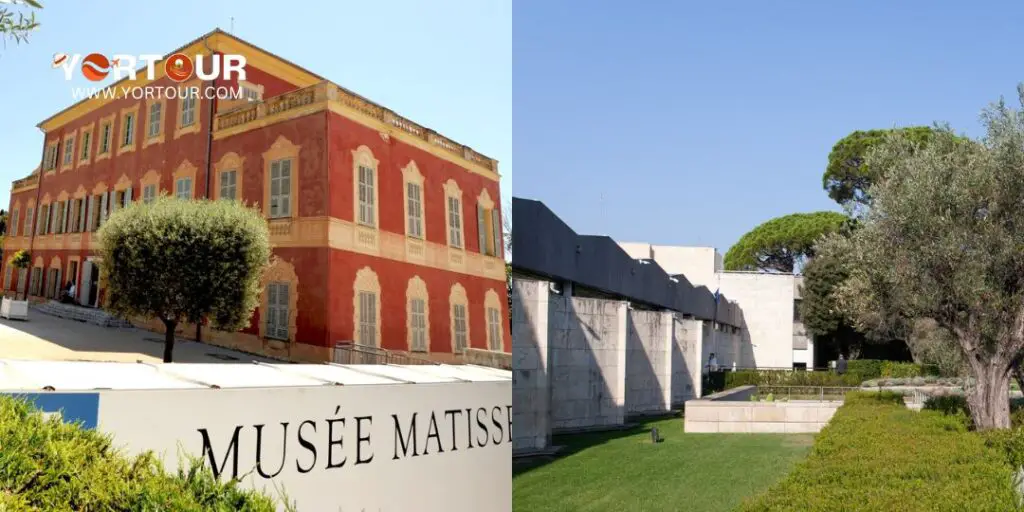
Nice has a rich artistic heritage, celebrated in its many museums. The Musée Matisse, located in a 17th-century villa, houses a comprehensive collection of works by Henri Matisse. The Marc Chagall National Museum showcases the artist vibrant and imaginative paintings, making Nice a cultural haven for art lovers.
Luxury Shopping and Fine Dining

Nice is also a destination for luxury shopping and gourmet dining. The city boutiques offer high-end fashion and unique local products, while its restaurants serve exquisite cuisine that blends French and Mediterranean influences. Dining in Nice is an experience, whether enjoying fresh seafood by the sea or savoring a meal at a Michelin-starred restaurant.
Bordeaux – Wine and Architectural Wonders
Bordeaux, famed for its world-class wines, offers an immersive experience for wine enthusiasts with tours of renowned vineyards such as Château Margaux and Château Lafite Rothschild. The city UNESCO-listed architecture, including the elegant Place de la Bourse and the Grand Théâtre, adds to its allure, showcasing classical and neoclassical splendor.
Complementing its wine heritage, Bordeaux boasts a vibrant culinary scene, with gourmet restaurants and lively markets like Marché des Capucins offering delights from fresh oysters to canelés. The scenic Garonne River enhances the city charm, providing opportunities for picturesque cruises, cycling through vineyards, and hiking in the nearby countryside.
Renowned Vineyards and Wine Tours

Bordeaux, synonymous with world-class wine, is a dream destination for oenophiles. The region vineyards produce some of the finest wines globally, and touring these estates offers not just tastings but also insights into the winemaking process. Visitors can explore famous vineyards like Château Margaux and Château Lafite Rothschild, experiencing the art of winemaking firsthand.
Historic Architecture and UNESCO Sites
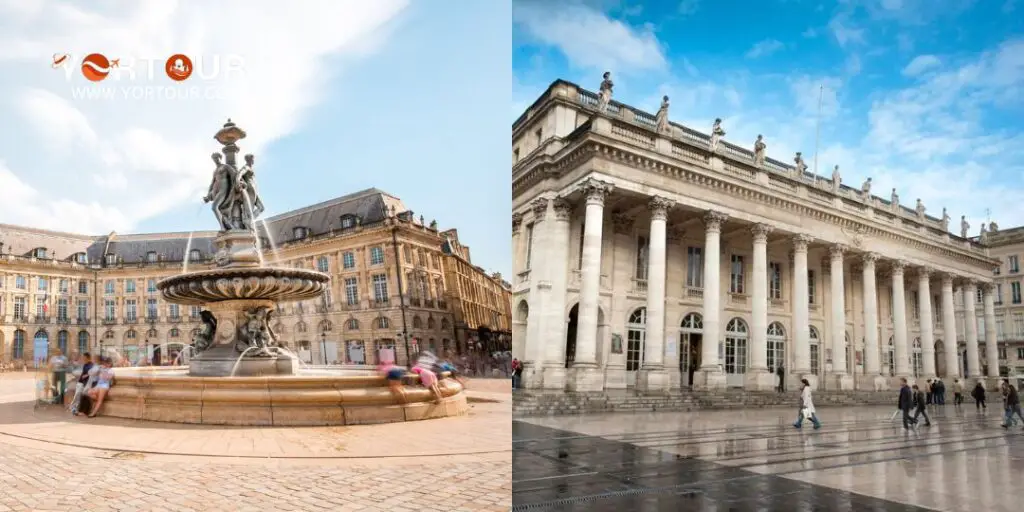
The city of Bordeaux itself is a UNESCO World Heritage site, celebrated for its classical and neoclassical architecture. The Place de la Bourse, with its stunning reflective water mirror, and the Grand Théâtre, a masterpiece of 18th-century design, are just two examples of the city’s architectural splendor.
Gastronomic Experiences and Local Markets
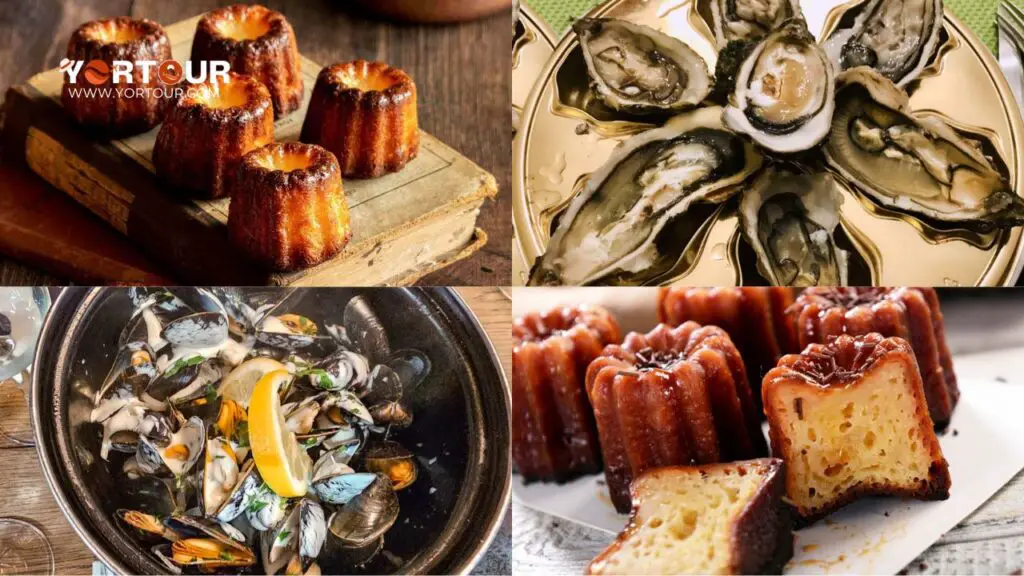
Bordeaux culinary scene is as impressive as its wine heritage. Gourmet restaurants and bustling local markets like Marché des Capucins offer a rich array of gastronomic delights. From fresh oysters from the nearby coast to traditional Bordeaux pastries like canelés, the city food offerings are sure to tantalize the taste buds.
Scenic River Cruises and Outdoor Activities

The Garonne River provides a picturesque backdrop for scenic cruises that offer stunning views of Bordeaux and its surroundings. Outdoor enthusiasts can also enjoy activities like cycling through the vineyards or hiking in the nearby countryside, making Bordeaux a perfect blend of urban and natural beauty.
Strasbourg – A Blend of Cultures
Strasbourg, nestled at the Franco-German border, blends French and Germanic cultures harmoniously. Its UNESCO-listed Grande Île, adorned with Gothic masterpieces like the Strasbourg Cathedral, epitomizes its rich architectural heritage.
The city modern districts, alongside the European Parliament, reflect its dual identity and progressive spirit, while Alsatian cuisine and acclaimed wineries add a distinct culinary allure. During the festive season, Strasbourg renowned Christmas markets create a magical atmosphere, showcasing its vibrant traditions and warm hospitality.
The Grande Île – A UNESCO World Heritage Site

Strasbourg, located on the border of France and Germany, boasts a unique blend of French and Germanic cultures. The Grande Île, the historic center of Strasbourg, is a UNESCO World Heritage site, featuring stunning examples of Gothic architecture, including the majestic Strasbourg Cathedral with its intricate façade and astronomical clock.
European Parliament and Modern Districts

Strasbourg is also home to the European Parliament, reflecting its importance as a center of European politics. The modern districts of the city, with their sleek buildings and green spaces, offer a contrast to the historic old town, showcasing Strasbourg dynamic and forward-thinking character.
Unique Alsatian Cuisine and Wineries

Alsatian cuisine is a delightful fusion of French and German culinary traditions. Dishes like choucroute garnie (sauerkraut with sausages) and flammekueche (a thin-crust pizza) are local favorites. The region wineries produce celebrated Rieslings and Gewürztraminers, and the Alsace Wine Route offers a scenic journey through picturesque vineyards and charming villages.
Christmas Markets and Festivities

Strasbourg is known for its enchanting Christmas markets, among the oldest and most beautiful in Europe. The city festive spirit comes alive during the holiday season, with twinkling lights, festive stalls, and the aroma of mulled wine filling the air. Strasbourg Christmas markets offer a magical experience that attracts visitors from all over the world.
Toulouse – The Pink City
Toulouse, known as the Pink City for its distinctive terracotta architecture, thrives as a hub for aerospace innovation, boasting museums like Cité de l’Espace and Aeroscopia that delve into space exploration and aviation history. Its vibrant atmosphere, fueled by a large student population, extends into a bustling nightlife scene with diverse bars and clubs.
Architectural wonders like the Capitole de Toulouse and Basilica of Saint-Sernin showcase the city grandeur and historical depth. Culinary delights include southern French specialties such as cassoulet and foie gras, complemented by local markets offering fresh produce and wines from nearby vineyards like Gaillac and Fronton.
Aerospace Industry and Museums

Toulouse, often referred to as the Pink City due to its terracotta buildings, is a hub for the aerospace industry. The Cité de l’Espace museum offers interactive exhibits and displays about space exploration, while the Aeroscopia Museum showcases the history of aviation with an impressive collection of aircraft.
Vibrant Student Life and Nightlife

Toulouse is home to one of the largest universities in France, giving the city a youthful and vibrant atmosphere. The bustling nightlife includes lively bars, music venues, and clubs that cater to all tastes, ensuring that the city stays lively well into the night.
Architectural Highlights – Capitole de Toulouse, Basilica of Saint-Sernin
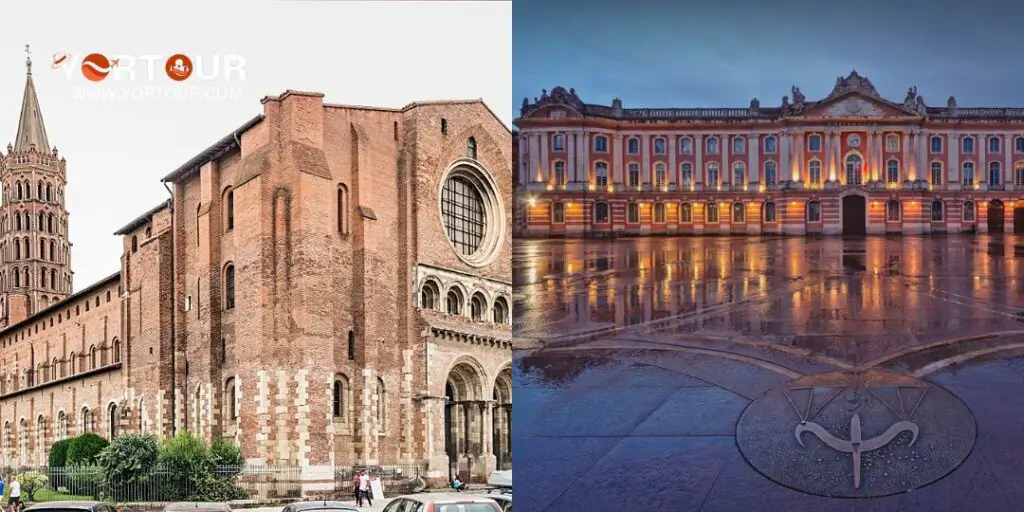
The Capitole de Toulouse, the city grand city hall and theatre, is an architectural marvel with its impressive façade and opulent interiors. The Basilica of Saint-Sernin, one of the largest Romanesque churches in Europe, is another highlight, attracting visitors with its stunning architecture and historical significance.
Southern French Cuisine and Wine
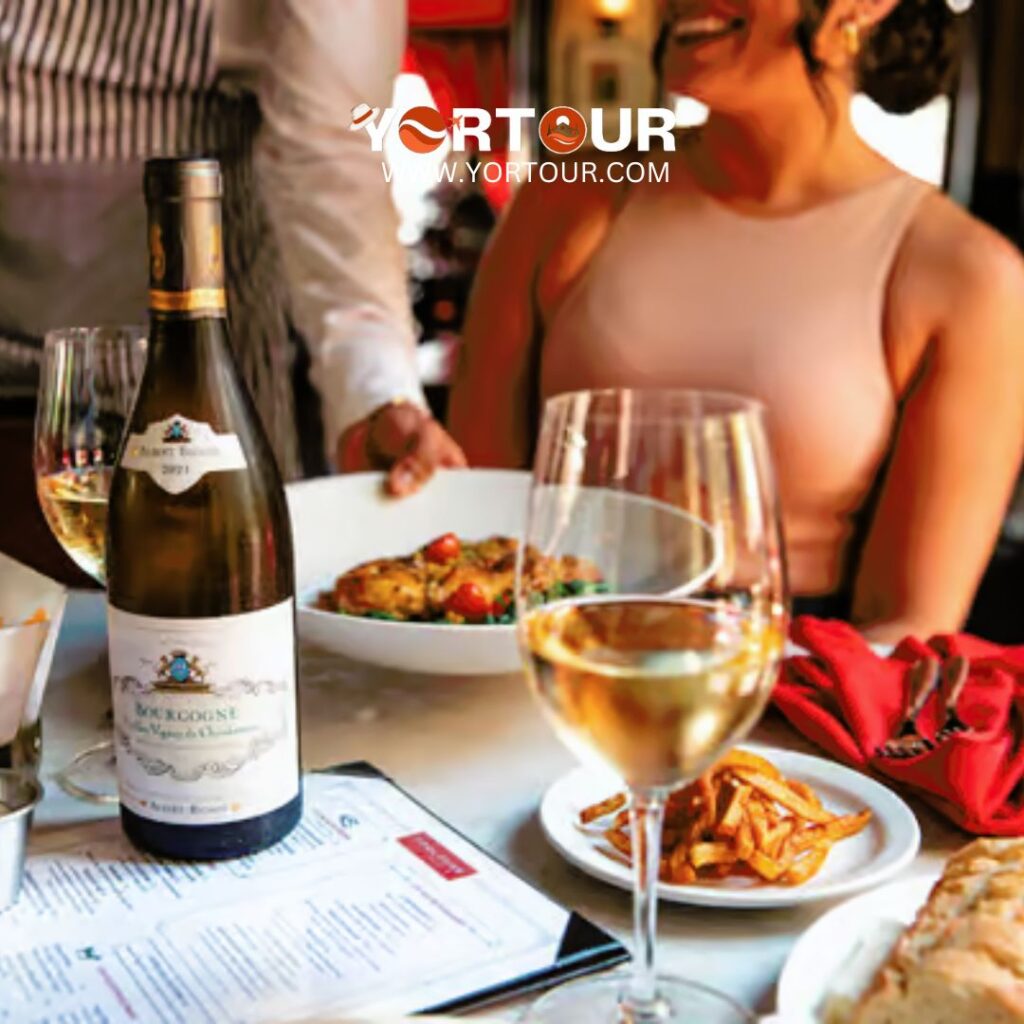
Toulouse offers a taste of southern French cuisine, with dishes like cassoulet (a hearty bean and meat stew) and foie gras being local specialties. The city markets, such as the Marché Victor Hugo, are perfect for exploring local produce and delicacies. Toulouse proximity to wine regions like Gaillac and Fronton ensures that excellent wines are always on hand to complement the food.
Nantes – A Hub of Innovation and History
Nantes, steeped in maritime history, showcases its past through landmarks like the Château des Ducs de Bretagne and the Gothic Cathedral of St. Peter and St. Paul. The city innovation shines bright on the Isle of Nantes with Les Machines de l’île, where mechanical wonders captivate visitors of all ages.
Green spaces like the Jardin des Plantes offer tranquil retreats amidst urban life, complementing Nantes’ commitment to sustainability with extensive bike paths and pedestrian-friendly streets. Culinary delights feature fresh seafood and Muscadet wine, reflecting the Atlantic influence on local cuisine.
Château des Ducs de Bretagne and Historic Sites

Nantes, a city with a rich maritime history, is home to the Château des Ducs de Bretagne, a stunning castle that now houses the Nantes History Museum. The city historic sites, including the Gothic Cathedral of St. Peter and St. Paul, offer glimpses into its past as a significant port and trading center.
The Creative Machines of the Isle of Nantes

The Isle of Nantes is a testament to the city innovative spirit, featuring Les Machines de l’île, a unique attraction where visitors can see and ride mechanical creatures like the famous Grand Éléphant. This creative project blends art, engineering, and imagination, making it a must-visit for all ages.
Green Spaces and Parks

Nantes is also known for its green spaces, with beautiful parks like the Jardin des Plantes offering a serene escape from the urban bustle. The city commitment to sustainability is evident in its extensive network of bike paths and pedestrian-friendly streets, encouraging outdoor activities and exploration.
Local Specialties – Seafood and Muscadet Wine

Nantes cuisine is heavily influenced by its proximity to the Atlantic Ocean, with fresh seafood being a staple. Dishes like beurre blanc (a butter sauce) and Muscadet wine, produced in the nearby vineyards, are local favorites that highlight the region culinary prowess.
Lille – A Northern Gem
Lille, a northern gem of France, exudes a unique Flemish charm through its architecture and cultural ambiance. The Grand Place stands as a testament to this influence, surrounded by ornate buildings and bustling cafés that epitomize the city historical richness.
Exploring Vieux Lille unveils cobblestone streets and boutique shops, while the Palais des Beaux-Arts showcases European masterpieces, making it a cultural beacon in Lille. The city culinary offerings, from moules-frites to artisanal beer, further enrich the visitor experience, blending French and Flemish flavors in a delightful gastronomic journey.
Flemish Influence and Architecture

Lille, located in northern France, showcases a distinct Flemish influence in its architecture and culture. The Grand Place, the city main square, is surrounded by beautiful buildings with ornate facades, reflecting its rich history and vibrant character.
Grand Place and Old Town Exploration
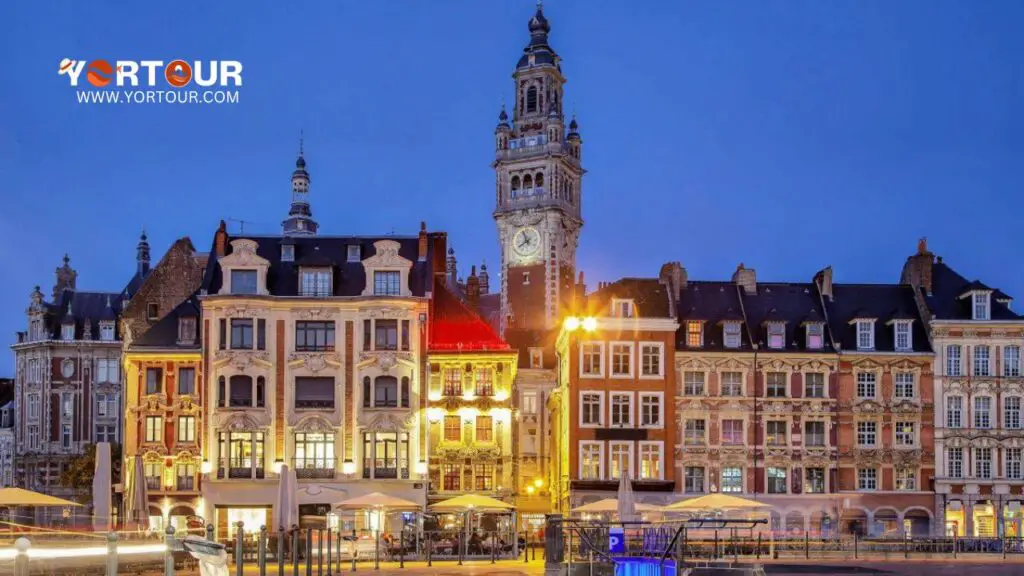
Exploring Lille old town, or Vieux Lille, reveals a charming blend of narrow cobblestone streets, historic buildings, and boutique shops. The Grand Place is a bustling hub of activity, with its impressive Vieille Bourse building and numerous cafés offering a perfect spot to soak in the city atmosphere.
Renowned Art Museums – Palais des Beaux-Arts
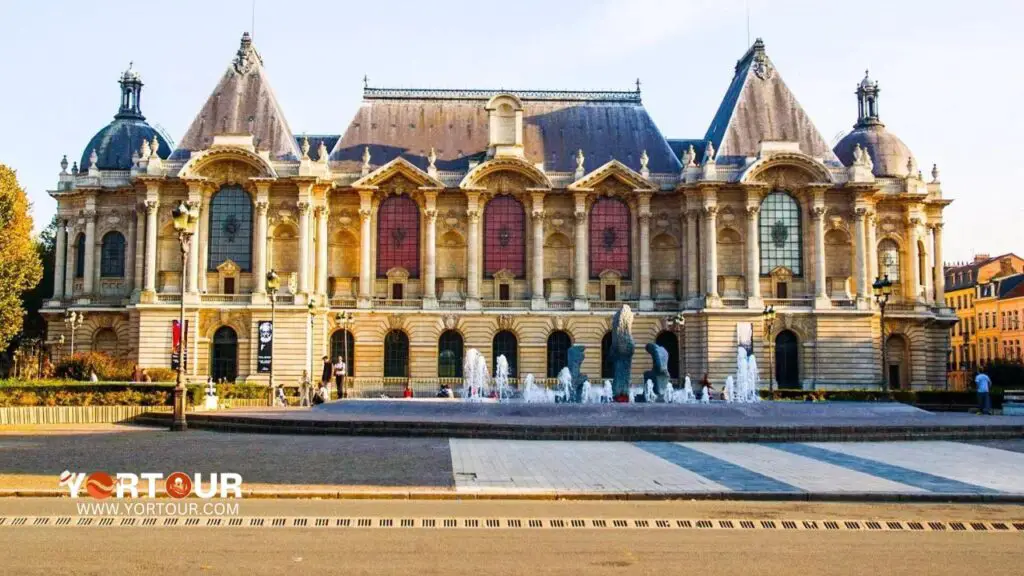
Lille is home to the Palais des Beaux-Arts, one of the largest art museums in France, housing an extensive collection of European art, including works by Rubens, Van Dyck, and Goya. The museum grand architecture and diverse exhibitions make it a cultural highlight of the city.
Culinary Delights – Waffles, Beer, and Regional Dishes

Lille culinary scene is a delightful fusion of French and Flemish influences. The city specialties include moules-frites (mussels with fries), carbonnade flamande (a Flemish beef stew), and delicious waffles. Lille is also known for its craft beer, with many local breweries offering unique and flavorful brews.
Montpellier – A Dynamic Southern City &
Montpellier, in southern France, seamlessly blends old-world charm with modern flair. Its historic center boasts medieval streets and elegant squares, while districts like Antigone showcase contemporary architecture by Ricardo Bofill. Nestled near the Mediterranean, Montpellier offers beaches like Palavas-les-Flots and La Grande-Motte, ideal for relaxation and water sports.
Cultural enthusiasts can explore the Musée Fabre and enjoy vibrant festivals throughout the year. Culinary delights, including local wines and regional specialties, add to Montpellier allure, making it a dynamic destination for travelers seeking a blend of history, culture, and coastal beauty.
Historical Center and Modern Developments

Montpellier, a vibrant city in southern France, seamlessly blends its historical heritage with modern developments. The historic center, with its medieval streets and elegant squares, contrasts with the contemporary architecture of districts like Antigone, designed by renowned architect Ricardo Bofill.
Mediterranean Proximity and Beaches

Montpellier proximity to the Mediterranean Sea makes it an ideal destination for beach lovers. The nearby beaches, such as Palavas-les-Flots and La Grande-Motte, offer golden sands and crystal-clear waters, perfect for relaxing and enjoying water sports.
Cultural Institutions and Events

The city cultural institutions, including the Musée Fabre and the Opéra Comédie, showcase Montpellier rich artistic and cultural scene. Throughout the year, numerous festivals and events, such as the Festival de Radio France and the Montpellier Dance Festival, add to the city vibrant cultural calendar.
Wine Regions and Local Cuisine

Montpellier is surrounded by renowned wine regions, including Languedoc-Roussillon, which produces a variety of excellent wines. The city culinary offerings reflect its southern location, with fresh produce, seafood, and regional specialties like tielle (a seafood pie) and brandade (a dish made from salt cod and olive oil) featuring prominently on menus.
Conclusion
The must-see cities in France each offer a unique blend of history, culture, and culinary delights, making them essential destinations for any traveler. From the romantic streets of Paris to the Mediterranean allure of Nice, these cities showcase the diverse and enchanting character of France. When planning a multi-city trip, consider the distinct attractions and experiences each city offers, ensuring a rich and varied exploration of this beautiful country.
Beyond the major cities, countless charming towns and villages await discovery, each contributing to the mosaic of French culture and heritage. Embrace the journey, savor the experiences, and let the beauty of France leave an indelible mark on your soul.
FAQs to Top Cities to Visit in France
1. What is the best time of year to visit France top cities?
The best time to visit varies by city. Generally, spring (April to June) and fall (September to October) offer pleasant weather and fewer crowds. Summer is ideal for beach destinations like Nice, while winter is perfect for cities with Christmas markets like Strasbourg.
2. How can I travel between France major cities?
France has an extensive and efficient train network, with high-speed TGV trains connecting major cities. Domestic flights, buses, and car rentals are also viable options for traveling between cities.
3. What are the must-see landmarks in Paris?
Key landmarks include the Eiffel Tower, Notre Dame Cathedral, the Louvre Museum, and the Sacré-Cœur Basilica in Montmartre. Each offers unique historical and cultural insights into the city.
4. What culinary experiences should I not miss in Lyon?
In Lyon, don’t miss dining at a traditional bouchon, visiting the Halles de Lyon Paul Bocuse food market, and trying local specialties like coq au vin and quenelles.
5. Are there any unique attractions in Marseille?
Yes, Marseille offers the vibrant Old Port, the fascinating MuCEM (Museum of European and Mediterranean Civilisations), and the natural beauty of Calanques National Park. Seafood, especially bouillabaisse, is a culinary highlight.
6. What cultural activities can I enjoy in Nice?
Nice boasts the Promenade des Anglais, the charming Old Town, and museums dedicated to artists like Matisse and Chagall. The city markets, luxury shopping, and fine dining also provide rich cultural experiences.
7. What makes Bordeaux a unique destination?
Bordeaux is renowned for its world-class vineyards and wine tours, historic architecture, and UNESCO sites. The city gastronomic scene and scenic river cruises add to its unique charm.
8. What are the top attractions in Strasbourg?
Strasbourg top attractions include the Grande Île (a UNESCO World Heritage site), the Strasbourg Cathedral, and the European Parliament. The city Christmas markets are particularly famous.
9. How can I explore Toulouse effectively?
Toulouse, known as the Pink City, can be explored by visiting its aerospace museums, enjoying its vibrant nightlife, and experiencing its architectural highlights like the Capitole de Toulouse and Basilica of Saint-Sernin.
10. What should I know about visiting Montpellier?
Montpellier offers a mix of historical and modern attractions. Key highlights include the historic center, the modern Antigone district, nearby Mediterranean beaches, and local wine regions. The city cultural events and festivals are also noteworthy.
